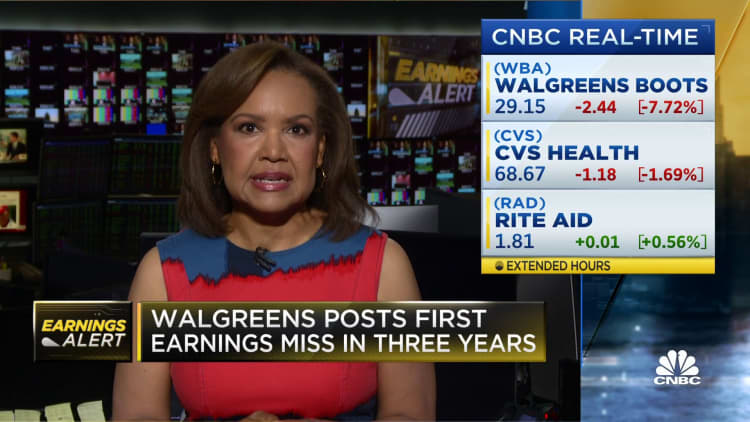
Walgreens Boots Alliance on Tuesday slashed its full-year earnings guidance as it fell short of Wall Street expectations for its fiscal third quarter due to lower consumer spending and a drop in demand for Covid vaccines and testing.
The retail pharmacy chain lowered its earnings guidance to a range of $4.00 to $4.05 per share for the full year, down from its previous forecast of $4.45 to $4.65 per share.
CEO Rosalind Brewer told analysts during the company's earnings call that she was disappointed by the reduced profit guidance for the year.
Brewer said soft demand for Covid vaccines and lower consumer spending is likely to extend into next year. She said the company is closing watching the end of fiscal stimulus and resumption of student loan payments as potential headwinds.
"Our customer is feeling the strain of higher inflation and interest rates, lower SNAP benefits and tax refunds and an uncertain economic outlook. They are pulling back on discretionary and seasonal spending and responding strongly to promotional activity," Brewer said.
Brewer said she is increasing Walgreen's cost-cutting initiative to $4.1 billion, which includes $800 million in savings for fiscal year 2024. The company is also working to increase profitability of its health-care segment, she said.
Brewer said although she's not satisfied with Tuesday's results, Walgreens had the right strategy to drive future growth.
Shares of Walgreens fell roughly 9% following the release.
Here's how Walgreens performed in its fiscal third quarter compared with what Wall Street was expecting based on analyst estimates polled by Refinitiv:
- Earnings: $1.00 per share adjusted, vs. $1.07 expected.
- Revenue: $35.42 billion, vs. $34.24 billion expected.
The earnings miss is the first time Walgreens has underperformed analyst expectations since July 2020.
But the company beat revenue expectations and posted sales growth, booking sales of $35.4 billion in the quarter — 8.6% higher than revenue of $32.6 billion in the same period a year earlier — due to growth in its retail pharmacy and health-care segments.
Walgreens booked net profit of $118 million for the quarter, or 14 cents per share unadjusted, a 59% drop from the $289 million in income the company reported for the same quarter last year. The decline was due primarily to lower operating income, according to the company.
Walgreens' U.S. retail pharmacy segment generated about $28 billion in sales for the quarter, an increase of 4.4% compared with the same period last year. Comparable sales at individual locations rose 7%.
Walgreens pharmacy sales also increased 6.3% compared with the same quarter last year, with comparable sales up nearly 10% due to price inflation in brand medications.
Total prescriptions filled in the quarter, including immunizations, increased by 0.1% for a total of 305 million. Covid vaccines administered during the period plummeted 83% to 800,000, down from 4.7 million in the same period last year.
"We had called out Covid as a wildcard heading into the quarter and have unfortunately seen less patient willingness to vaccinate," Brewer said.
Walgreens expects to administer 9 million to 10 million Covid vaccines in 2024, in line with a typical flu season, compared with 12.5 million projected vaccinations in 2023, Brewer said.
Sales in Walgreens U.S. health-care segment came in at $2 billion, a $1.4 billion increase compared with the same period last year.
Primary-care provider VillageMD, which includes urgent care provider Summit Health, saw revenue grow by 22%. Sales at Walgreens at-home health-care provider CareCentrix increased 15% due to additional service offerings.
Still, the health-care segment took a loss of $113 million in the quarter before interest, tax, depreciation and amortization, driven by an expansion of VillageMD and fewer patient visits at Summit Health's CityMD urgent care clinics due to a weaker respiratory virus season.
"While we're confident in the range and scale of our health-care business, we are disappointed with the pace of our path to profitability," John Driscoll, president of Walgreens health-care business, told analysts during the company's Tuesday call.
"We're taking immediate actions to drive improved profitability," Driscoll said. "We anticipate this year will remain a transition year as we take action to deliver value and drive profitability."


